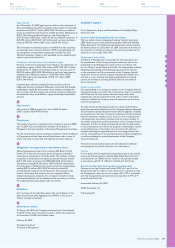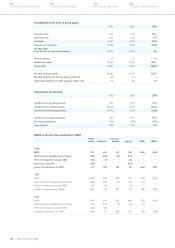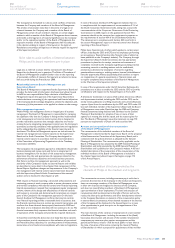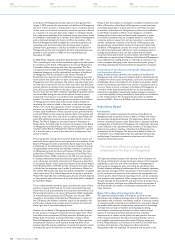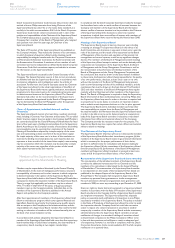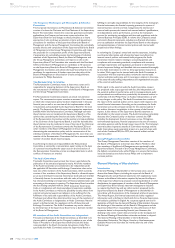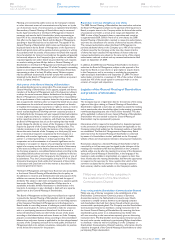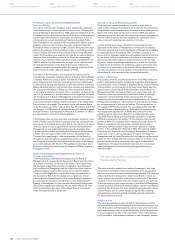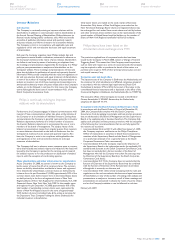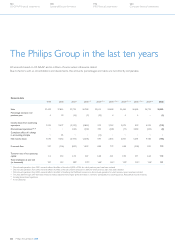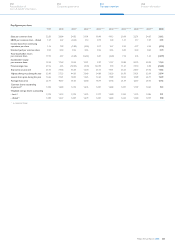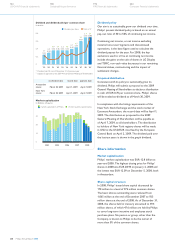Philips 2008 Annual Report Download - page 258
Download and view the complete annual report
Please find page 258 of the 2008 Philips annual report below. You can navigate through the pages in the report by either clicking on the pages listed below, or by using the keyword search tool below to find specific information within the annual report.
The Corporate Governance and Nomination & Selection
Committee
The Corporate Governance and Nomination & Selection Committee
consists of at least the Chairman and Vice-Chairman of the Supervisory
Board. The Committee reviews the corporate governance principles
applicable to the Company at least once a year, and advises the
Supervisory Board on any changes to these principles as it deems
appropriate. It also (a) draws up selection criteria and appointment
procedures for members of the Supervisory Board, the Board of
Management and the Group Management Committee; (b) periodically
assesses the size and composition of the Supervisory Board, the Board
of Management and the Group Management Committee, and makes
the proposals for a composition profile of the Supervisory Board,
if appropriate; (c) periodically assesses the functioning of individual
members of the Supervisory Board, the Board of Management and
the Group Management Committee, and reports on this to the
Supervisory Board. The Committee also consults with the President/
CEO and the Board of Management on candidates to fill vacancies
on the Supervisory Board, the Board of Management and the Group
Management Committee, and advises the Supervisory Board on the
candidates for appointment. It further supervises the policy of the
Board of Management on the selection criteria and appointment
procedures for Philips Executives.
The Remuneration Committee
The Remuneration Committee meets at least twice a year and is
responsible for preparing decisions of the Supervisory Board on
the remuneration of individual members of the Board of Management
and the Group Management Committee.
The Remuneration Committee prepares an annual remuneration
report. The remuneration report contains an account of the manner
in which the remuneration policy has been implemented in the past
financial year, as well as an overview of the implementation of the
remuneration policy planned by the Supervisory Board for the next
year(s). The Supervisory Board aims to have appropriate experience
available within the Remuneration Committee. Although currently
these functions are not combined, the Supervisory Board is of the
opinion that, considering the functions and tasks of the Chairman
of the Remuneration Committee and the position and responsibilities
of the Chairman of the Supervisory Board, it could be desirable that
these functions may be combined in view of the role of the Chairman
of the Remuneration Committee towards the President/CEO and
other members of the Board of Management in the procedures for
determining the remuneration policy and the remuneration of the
individual members of the Board of Management. No more than one
member of the Remuneration Committee shall be an executive board
member of another Dutch listed company.
In performing its duties and responsibilities the Remuneration
Committee is assisted by a remuneration expert acting on the basis
of a protocol ensuring that the expert acts on the instructions of
the Remuneration Committee and on an independent basis in which
conflicts of interests are avoided.
The Audit Committee
The Audit Committee meets at least four times a year, before the
publication of the annual and quarterly results. All of the members
of the Audit Committee are considered to be independent under
the applicable US Securities and Exchange Commission rules and at
least one of the members of the Audit Committee, which currently
consists of four members of the Supervisory Board, is a financial expert
as set out in the Dutch Corporate Governance Code and each member
is financially literate. In accordance with this code, a financial expert
has relevant knowledge and experience of financial administration and
accounting at the company in question. The Supervisory Board considers
the fact of being compliant with the Dutch
Corporate Governance
Code, in combination with the knowledge and experience available
in the Audit Committee as well as the possibility to take advice from
internal and external experts and advisors, to be sufficient for the
fulfillment of the tasks and responsibilities of the Audit Committee.
The Supervisory Board has determined that none of the members of
the Audit Committee is designated as an Audit Committee financial
expert as defined under the regulations of the US Securities and
Exchange Commission. The Audit Committee may not be chaired
by the Chairman of the Supervisory Board or by a (former) member
of the Board of Management.
All members of the Audit Committee are independent
The tasks and functions of the Audit Committee, as described in its
charter, which is published on the Company's website as part of the
Rules of Procedure of the Supervisory Board, include the duties
recommended in the Dutch Corporate Governance Code. More
specifically, the Audit Committee assists the Supervisory Board in
fulfilling its oversight responsibilities for the integrity of the Company’s
financial statements, the financial reporting process, the system of
internal business controls and risk management, the internal and
external audit process, the internal and external auditor’s qualifications,
its independence and its performance, as well as the Company’s
process for monitoring compliance with laws and regulations and the
General Business Principles (GBP). It reviews the Company’s annual
and interim financial statements, including non-financial information,
prior to publication and advises the Supervisory Board on the adequacy
and appropriateness of internal control policies and internal audit
programs and their findings.
In reviewing the Company’s annual and interim statements, including
non-financial information, and advising the Supervisory Board on
internal control policies and internal audit programs, the Audit
Committee reviews matters relating to accounting policies and
compliance with accounting standards, compliance with statutory
and legal requirements and regulations, particularly in the financial
domain. Important findings and identified risks are examined thoroughly
by the Audit Committee in order to allow appropriate measures to
be taken. With regard to the internal audit, the Audit Committee, in
cooperation with the external auditor, reviews the internal audit
charter, audit plan, audit scope and its coverage in relation to the scope
of the external audit, staffing, independence and organizational structure
of the internal audit function.
With regard to the external audit, the Audit Committee reviews
the proposed audit scope, approach and fees, the independence of
the external auditor, its performance and its (re-)appointment, audit
and permitted non-audit services provided by the external auditor in
conformity with the Philips Policy on Auditor Independence, as well
as any changes to this policy. The Audit Committee also considers
the report of the external auditor and its report with respect to the
annual financial statements. According to the procedures, the Audit
Committee acts as the principal contact for the external auditor if
the auditor discovers irregularities in the content of the financial
reports. It also advises on the Supervisory Board’s statement to
shareholders in the annual accounts. The Audit Committee periodically
discusses the Company’s policy on business controls, the GBP
including the deployment thereof, overviews on tax, IT, litigation,
environmental exposures, financial exposures in the area of treasury,
real estate, pensions, and the Group’s major areas of risk. The Company’s
external auditor, in general, attends all Committee meetings and the
Audit Committee meets separately at least on a quarterly basis with
each of the President/CEO, the CFO, the internal auditor and the
external auditor.
Group Management Committee
The Group Management Committee consists of the members of
the Board of Management and certain key officers. Members other
than members of the Board of Management are appointed by the
Supervisory Board. The task of the Group Management Committee,
the highest consultative body within Philips, is to ensure that business
issues and practices are shared across Philips and to implement
common policies.
General Meeting of Shareholders
Introduction
A General Meeting of Shareholders is held at least once a year to
discuss the Annual Report, including the report of the Board of
Management, the annual financial statements with explanatory notes
thereto and additional information required by law, and the Report
of the Supervisory Board, any proposal concerning dividends or other
distributions, the appointment of members of the Board of Management
and Supervisory Board (if any), important management decisions
as required by Dutch law, and any other matters proposed by the
Supervisory Board, the Board of Management or shareholders in
accordance with the provisions of the Company’s articles of association.
The Annual Report, the financial statements and other regulated
information such as defined in the Dutch Act on Financial Supervision,
will solely be published in English. As a separate agenda item and in
application of Dutch law, the General Meeting of Shareholders discusses
the discharge of the members of the Board of Management and the
Supervisory Board from responsibility for the performance of their
respective duties in the preceding financial year. However, this
discharge only covers matters that are known to the
Company and
the General Meeting of Shareholders when the resolution
is adopted.
The General Meeting of Shareholders is held in Eindhoven,
Amsterdam, Rotterdam, The Hague, Utrecht or Haarlemmermeer
(Schiphol Airport) no later than six months after the end of the
financial year.
Philips Annual Report 2008258
180
Sustainability performance
192
IFRS financial statements
244
Company financial statements
124
US GAAP financial statements



